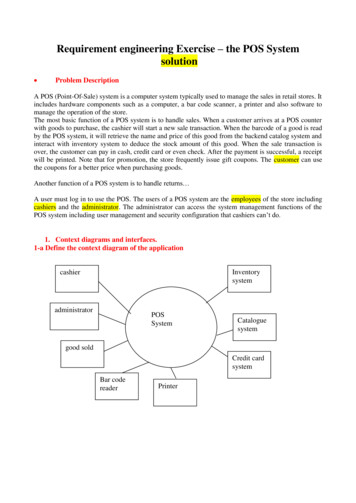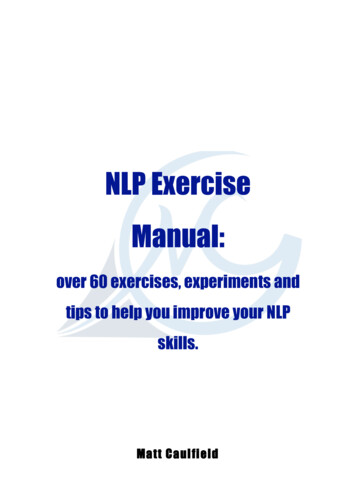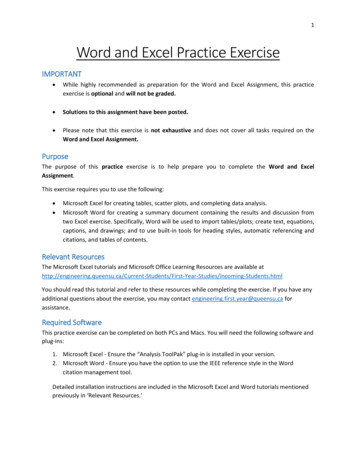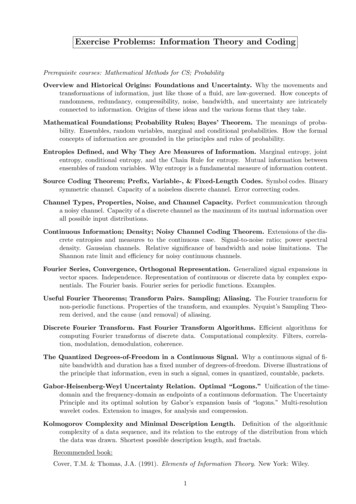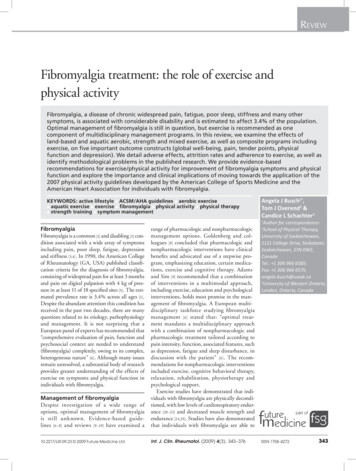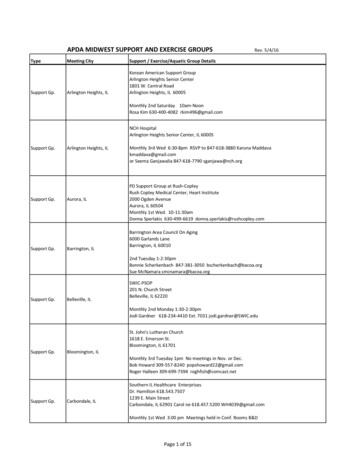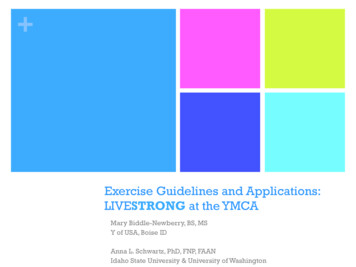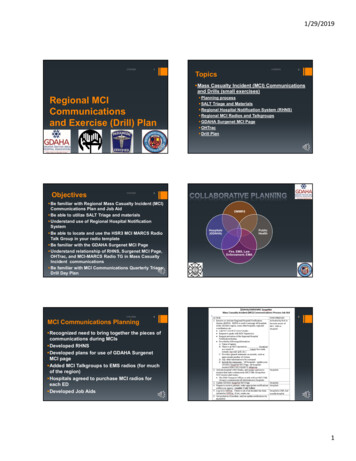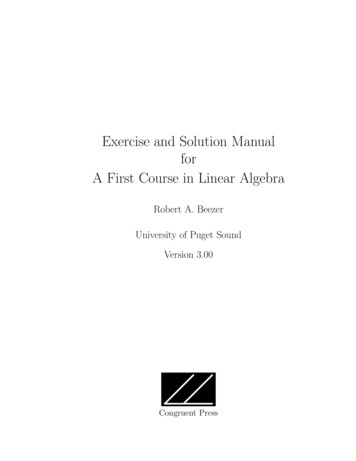
Transcription
Exercise and Solution ManualforA First Course in Linear AlgebraRobert A. BeezerUniversity of Puget SoundVersion 3.00Congruent Press
Robert A. Beezer is a Professor of Mathematics at the University of Puget Sound, where he has been on thefaculty since 1984. He received a B.S. in Mathematics (with an Emphasis in Computer Science) from theUniversity of Santa Clara in 1978, a M.S. in Statistics from the University of Illinois at Urbana-Champaignin 1982 and a Ph.D. in Mathematics from the University of Illinois at Urbana-Champaign in 1984.In addition to his teaching at the University of Puget Sound, he has made sabbatical visits to the Universityof the West Indies (Trinidad campus) and the University of Western Australia. He has also given severalcourses in the Master’s program at the African Institute for Mathematical Sciences, South Africa. He hasbeen a Sage developer since 2008.He teaches calculus, linear algebra and abstract algebra regularly, while his research interests include theapplications of linear algebra to graph theory. His professional website is at http://buzzard.ups.edu.EditionVersion 3.00December 7, 2012Cover DesignAidan MeachamPublisherRobert A. BeezerCongruent PressGig Harbor, Washington, USAc 2004—2012Robert A. BeezerPermission is granted to copy, distribute and/or modify this document under the terms of the GNU FreeDocumentation License, Version 1.2 or any later version published by the Free Software Foundation; withno Invariant Sections, no Front-Cover Texts, and no Back-Cover Texts. A copy of the license is included inthe appendix entitled “GNU Free Documentation License”.The most recent version can always be found at http://linear.pugetsound.edu.
ContentsSystems of Linear EquationsWhat is Linear Algebra? . . . . . . .Solving Systems of Linear EquationsReduced Row-Echelon Form . . . . .Types of Solution Sets . . . . . . . .Homogeneous Systems of EquationsNonsingular Matrices . . . . . . . . .1116131823VectorsVector Operations . . . . . .Linear Combinations . . . . .Spanning Sets . . . . . . . . .Linear Independence . . . . .Linear Dependence and SpansOrthogonality . . . . . . . . .28283233414851MatricesMatrix Operations . . . . . . . . . . . . . . . . .Matrix Multiplication . . . . . . . . . . . . . . .Matrix Inverses and Systems of Linear EquationsMatrix Inverses and Nonsingular Matrices . . . .Column and Row Spaces . . . . . . . . . . . . . .Four Subsets . . . . . . . . . . . . . . . . . . . .53535761656772Vector SpacesVector Spaces . . . . . . . . . . . .Subspaces . . . . . . . . . . . . . .Linear Independence and SpanningBases . . . . . . . . . . . . . . . .Dimension . . . . . . . . . . . . . .Properties of Dimension . . . . . .77778084919599. . . . .Sets. . . . . . .Determinants101Determinant of a Matrix . . . . . . . . . . . . . . . . . . . . . . . . . . . . . . . . . . . . . . . . . . 101Properties of Determinants of Matrices . . . . . . . . . . . . . . . . . . . . . . . . . . . . . . . . . . 104Eigenvalues106Eigenvalues and Eigenvectors . . . . . . . . . . . . . . . . . . . . . . . . . . . . . . . . . . . . . . . 106Properties of Eigenvalues and Eigenvectors . . . . . . . . . . . . . . . . . . . . . . . . . . . . . . . 111Similarity and Diagonalization . . . . . . . . . . . . . . . . . . . . . . . . . . . . . . . . . . . . . . 113Linear TransformationsLinear Transformations . . . . . .Injective Linear Transformations .Surjective Linear TransformationsInvertible Linear Transformations .iii.117117121126131
RepresentationsVector Representations . . . .Matrix Representations . . .Change of Basis . . . . . . . .Orthonormal Diagonalization.Archetypes.136136137146149150iv
Chapter SLESystems of Linear EquationsSection WILAWhat is Linear Algebra?C10 (Robert Beezer) In Example TMP the first table lists the cost (per kilogram) to manufacture each ofthe three varieties of trail mix (bulk, standard, fancy). For example, it costs 3.69 to make one kilogramof the bulk variety. Re-compute each of these three costs and notice that the computations are linear incharacter.M70 (Robert Beezer) In Example TMP two different prices were considered for marketing standard mixwith the revised recipes (one-third peanuts in each recipe). Selling standard mix at 5.50 resulted in sellingthe minimum amount of the fancy mix and no bulk mix. At 5.25 it was best for profits to sell the maximumamount of fancy mix and then sell no standard mix. Determine a selling price for standard mix that allowsfor maximum profits while still selling some of each type of mix.Solution (Robert Beezer) If the price of standard mix is set at 5.292, then the profit function has a zerocoefficient on the variable quantity f . So, we can set f to be any integer quantity in {825, 826, . . . , 960}.All but the extreme values (f 825, f 960) will result in production levels where some of every mix ismanufactured. No matter what value of f is chosen, the resulting profit will be the same, at 2,664.60.Section SSLESolving Systems of Linear EquationsC10 (Robert Beezer) Find a solution to the system in Example IS where x3 6 and x4 2. Find twoother solutions to the system. Find a solution where x1 17 and x2 14. How many possible answersare there to each of these questions?C20 (Robert Beezer) Each archetype (Archetypes) that is a system of equations begins by listing somespecific solutions. Verify the specific solutions listed in the following archetypes by evaluating the system ofequations with the solutions listed.Archetype A, Archetype B, Archetype C, Archetype D, Archetype E, Archetype F, Archetype G, ArchetypeH, Archetype I, Archetype JC30 (Chris Black)Find all solutions to the linear system:x y 52x y 3Solution (Chris Black)Solving each equation for y, we have the equivalent systemy 5 xy 2x 3.1
2Robert Beezer§SSLESetting these expressions for y equal, we have the equation 5 x 2x 3, which quickly leads to x 83 .Substituting for x in the first equation, we have y 5 x 5 83 73 . Thus, the solution is x 83 , y 37 .C31 (Chris Black)Find all solutions to the linear system:3x 2y 1x y 24x 2y 2C32 (Chris Black)Find all solutions to the linear system:x 2y 8x y 2x y 4C33 (Chris Black)Find all solutions to the linear system:x y z 1x y z 1z 2C34 (Chris Black)Find all solutions to the linear system:x y z 5x y z 3x y z 0C50 (Robert Beezer) A three-digit number has two properties. The tens-digit and the ones-digit add up to5. If the number is written with the digits in the reverse order, and then subtracted from the original number,the result is 792. Use a system of equations to find all of the three-digit numbers with these properties.Solution (Robert Beezer) Let a be the hundreds digit, b the tens digit, and c the ones digit. Then thefirst condition says that b c 5. The original number is 100a 10b c, while the reversed number is100c 10b a. So the second condition is792 (100a 10b c) (100c 10b a) 99a 99cSo we arrive at the system of equationsb c 599a 99c 792Using equation operations, we arrive at the equivalent systema c 8b c 5We can vary c and obtain infinitely many solutions. However, c must be a digit, restricting us to ten values(0 – 9). Furthermore, if c 1, then the first equation forces a 9, an impossibility. Setting c 0, yields850 as a solution, and setting c 1 yields 941 as another solution.C51 (Robert Beezer) Find all of the six-digit numbers in which the first digit is one less than the second,the third digit is half the second, the fourth digit is three times the third and the last two digits form anumber that equals the sum of the fourth and fifth. The sum of all the digits is 24. (From The MENSAPuzzle Calendar for January 9, 2006.)Solution (Robert Beezer) Let abcdef denote any such six-digit number and convert each requirement inthe problem statement into an equation.a b 1
§SSLEFCLA: Exercises and Solutions31b2d 3cc 10e f d e24 a b c d e fIn a more standard form this becomesa b 1 b 2c 0 3c d 0 d 9e f 0a b c d e f 24Using equation operations (or the techniques of the upcoming Section RREF), this system can be convertedto the equivalent system16a f 57516b f 6758c f 3758d f 92511e f 175Clearly, choosing f 0 will yield the solution abcde 563910. Furthermore, to have the variables result insingle-digit numbers, none of the other choices for f (1, 2, . . . , 9) will yield a solution.C52 (Robert Beezer) Driving along, Terry notices that the last four digits on his car’s odometer arepalindromic. A mile later, the last five digits are palindromic. After driving another mile, the middle fourdigits are palindromic. One more mile, and all six are palindromic. What was the odometer reading whenTerry first looked at it? Form a linear system of equations that expresses the requirements of this puzzle.(Car Talk Puzzler, National Public Radio, Week of January 21, 2008) (A car odometer displays six digitsand a sequence is a palindrome if it reads the same left-to-right as right-to-left.)Solution (Robert Beezer)198888 is one solution, and David Braithwaite found 199999 as another.M10 (Robert Beezer) Each sentence below has at least two meanings. Identify the source of the doublemeaning, and rewrite the sentence (at least twice) to clearly convey each meaning.1. They are baking potatoes.2. He bought many ripe pears and apricots.3. She likes his sculpture.4. I decided on the bus.Solution (Robert Beezer)1. Does “baking” describe the potato or what is happening to the potato?Those are potatoes that are used for baking.The potatoes are being baked.2. Are the apricots ripe, or just the pears? Parentheses could indicate just what the adjective “ripe” ismeant to modify. Were there many apricots as well, or just many pears?He bought many pears and many ripe apricots.He bought apricots and many ripe pears.
4Robert Beezer§SSLE3. Is “sculpture” a single physical object, or the sculptor’s style expressed over many pieces and manyyears?She likes his sculpture of the girl.She likes his sculptural style.4. Was a decision made while in the bus, or was the outcome of a decision to choose the bus. Would thesentence “I decided on the car,” have a similar double meaning?I made my decision while on the bus.I decided to ride the bus.M11 (Robert Beezer) Discuss the difference in meaning of each of the following three almost identicalsentences, which all have the same grammatical structure. (These are due to Keith Devlin.)1. She saw him in the park with a dog.2. She saw him in the park with a fountain.3. She saw him in the park with a telescope.Solution (Robert Beezer) We know the dog belongs to the man, and the fountain belongs to the park. Itis not clear if the telescope belongs to the man, the woman, or the park.M12 (Robert Beezer) The following sentence, due to Noam Chomsky, has a correct grammatical structure,but is meaningless. Critique its faults. “Colorless green ideas sleep furiously.” (Chomsky, Noam. SyntacticStructures, The Hague/Paris: Mouton, 1957. p. 15.)Solution (Robert Beezer) In adjacent pairs the words are contradictory or inappropriate. Somethingcannot be both green and colorless, ideas do not have color, ideas do not sleep, and it is hard to sleepfuriously.M13 (Robert Beezer) Read the following sentence and form a mental picture of the situation.The baby cried and the mother picked it up.What assumptions did you make about the situation?Solution (Robert Beezer) Did you assume that the baby and mother are human?Did you assume that the baby is the child of the mother?Did you assume that the mother picked up the baby as an attempt to stop the crying?M14 (Robert Beezer) Discuss the difference in meaning of the following two almost identical sentences,which have nearly identical grammatical structure. (This antanaclasis is often attributed to the comedianGroucho Marx, but has earlier roots.)1. Time flies like an arrow.2. Fruit flies like a banana.M30 (David Beezer) This problem appears in a middle-school mathematics textbook: Together Dan andDiane have 20. Together Diane and Donna have 15. How much do the three of them have in total?(Transition Mathematics, Second Edition, Scott Foresman Addison Wesley, 1998. Problem 5–1.19.)Solution (Robert Beezer) If x, y and z represent the money held by Dan, Diane and Donna, then y 15 zand x 20 y 20 (15 z) 5 z. We can let z take on any value from 0 to 15 without any of thethree amounts being negative, since presumably middle-schoolers are too young to assume debt.Then the total capital held by the three is x y z (5 z) (15 z) z 20 z. So their combined holdings can range anywhere from 20 (Donna is broke) to 35 (Donna is flush).We will have more to say about this situation in Section TSS, and specifically Theore
07.12.2012 · Exercise and Solution Manual for A First Course in Linear Algebra Robert A. Beezer University of Puget Sound Version 3.00 Congruent Press . Robert A. Beezer is a Professor of Mathematics at the University of Puget Sound, where he has been on the faculty since 1984. He received a B.S. in Mathematics (with an Emphasis in Computer Science) from the University of Santa Clara in

